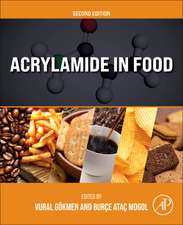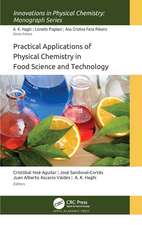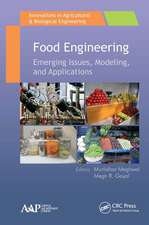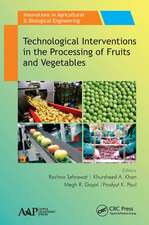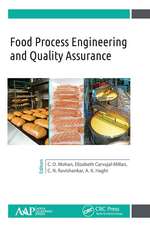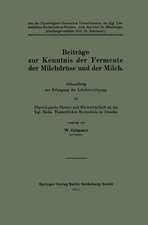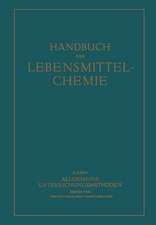Acrylamide in Food: Analysis, Content and Potential Health Effects
Editat de Vural Gokmenen Limba Engleză Paperback – 11 aug 2015
The book is designed for food scientists, technologists, toxicologists, and food industry workers, providing an invaluable industrial reference book that is also ideal for academic libraries that cover the domains of food production or food science.
As the World Health Organization has declared that acrylamide represents a potential health risk, there has been, in recent years, an increase in material on the formation and presence of acrylamide in different foods. This book compiles and synthesizes that information in a single source, thus enabling those in one discipline to become familiar with the concepts and applications in other disciplines of food science.
- Provides latest information on acrylamide in various foods (bakery products, fried potato products, coffee, battered products, water, table olives, etc.)
- Explores acrylamide in the food chain in the context of harm, such as acrylamide and cancer, neuropathology of acrylamide, maternal acrylamide and effects on offspring and its toxic effects in tissues
- Touches on a variety of subjects, including acrylamide, high heated foods, dietary acrylamide, acrylamide formation, N-acetyl-S-(2-carbamoylethyl)-cysteine (AAMA), acrylamide removal, L-asparaginase, and acrylamide determination
- Presents recent analytical methodologies for acrylamide determination, including liquid chromatographic tandem mass spectrometry and gas chromatography-mass spectrometry
Preț: 810.55 lei
Preț vechi: 1130.87 lei
-28% Nou
Puncte Express: 1216
Preț estimativ în valută:
155.12€ • 161.35$ • 128.06£
155.12€ • 161.35$ • 128.06£
Carte tipărită la comandă
Livrare economică 07-21 aprilie
Preluare comenzi: 021 569.72.76
Specificații
ISBN-13: 9780128028322
ISBN-10: 0128028327
Pagini: 532
Ilustrații: 20 illustrations
Dimensiuni: 191 x 235 x 28 mm
Greutate: 0.94 kg
Editura: ELSEVIER SCIENCE
ISBN-10: 0128028327
Pagini: 532
Ilustrații: 20 illustrations
Dimensiuni: 191 x 235 x 28 mm
Greutate: 0.94 kg
Editura: ELSEVIER SCIENCE
Cuprins
1. Acrylamide formation mechanism
2. Challenges in estimating dietary acrylamide intake
3. Secular trends in food acrylamide
Acrylamide, The Food Chain in the Context of Harm
4. Acrylamide Intake, Its Effects on tissues and Cancer
5. Maternal acrylamide and effects on offspring
6. Metabolism of acrylamide in humans and biomarkers of the exposure to acrylamide
Acrylamide in Foods
7. Acrylamide in bakery products
8. Acrylamide in fried potato products
9. Acrylamide in coffee and coffee substitutes
10. Acrylamide in soybean products, roasted nuts and dried fruits
11. Acrylamide in tea products
12. Acrylamide in table olives
13. Acrylamide in battered products
14. Acrylamide in surface and drinking water
Interactions and Reductions
15. Use of nucleophilic compounds, and their combination, for acrylamide removal
16. Lipid oxidation promotes acrylamide formation in fat-rich systems
17. Relationship between antioxidants and acrylamide formation
18. Interaction between bioactive carbonyl compounds and asparagine and impact on acrylamide
19. Effect of inorganic salts on acrylamide formation in cereal matrices
20. Inhibition of acrylamide formation by vanadium salt in French fries and potato chips
21. Impact of L-asparaginase on acrylamide content in fried potato and bakery products
22. Alternative technologies for the mitigation of acrylamide in processed foods
23. Analysis of acrylamide in foods with special emphasis on sample preparation and gas chromatography-mass spectrometry detection
Methods of Analysis
24. Liquid chromatographic tandem mass spectrometry to determine acrylamide in foods
25. Quantitation of acrylamide in foods by high-resolution mass spectrometry
26. Detection of acrylamide by biosensors
2. Challenges in estimating dietary acrylamide intake
3. Secular trends in food acrylamide
Acrylamide, The Food Chain in the Context of Harm
4. Acrylamide Intake, Its Effects on tissues and Cancer
5. Maternal acrylamide and effects on offspring
6. Metabolism of acrylamide in humans and biomarkers of the exposure to acrylamide
Acrylamide in Foods
7. Acrylamide in bakery products
8. Acrylamide in fried potato products
9. Acrylamide in coffee and coffee substitutes
10. Acrylamide in soybean products, roasted nuts and dried fruits
11. Acrylamide in tea products
12. Acrylamide in table olives
13. Acrylamide in battered products
14. Acrylamide in surface and drinking water
Interactions and Reductions
15. Use of nucleophilic compounds, and their combination, for acrylamide removal
16. Lipid oxidation promotes acrylamide formation in fat-rich systems
17. Relationship between antioxidants and acrylamide formation
18. Interaction between bioactive carbonyl compounds and asparagine and impact on acrylamide
19. Effect of inorganic salts on acrylamide formation in cereal matrices
20. Inhibition of acrylamide formation by vanadium salt in French fries and potato chips
21. Impact of L-asparaginase on acrylamide content in fried potato and bakery products
22. Alternative technologies for the mitigation of acrylamide in processed foods
23. Analysis of acrylamide in foods with special emphasis on sample preparation and gas chromatography-mass spectrometry detection
Methods of Analysis
24. Liquid chromatographic tandem mass spectrometry to determine acrylamide in foods
25. Quantitation of acrylamide in foods by high-resolution mass spectrometry
26. Detection of acrylamide by biosensors


